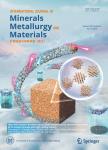Reduction mechanism of high-chromium vanadium–titanium magnetite pellets by H_2–CO–CO_2 gas mixtures
Reduction mechanism of high-chromium vanadium–titanium magnetite pellets by H_2–CO–CO_2 gas mixtures作者机构:School of Material and MetallurgyNortheastern University
出 版 物:《International Journal of Minerals,Metallurgy and Materials》 (矿物冶金与材料学报(英文版))
年 卷 期:2015年第22卷第6期
页 面:562-572页
核心收录:
学科分类:080602[工学-钢铁冶金] 08[工学] 0806[工学-冶金工程]
基 金:financially supported by the National Natural Science Foundation of China (No. 51090384) the National High-Tech Research and Development Program of China (No. 2012AA062302) the Fundamental Research Funds for the Central Universities of China (Nos. N110202001 and N130602003)
主 题:magnetite ore reduction phase transformation reaction mechanism kinetics
摘 要:The reduction of high-chromium vanadium–titanium magnetite as a typical titanomagnetite containing 0.95wt% V2O5 and 0.61wt% Cr2O3 by H2–CO–CO2 gas mixtures was investigated from 1223 to 1373 K. Both the reduction degree and reduction rate increase with increasing temperature and increasing hydrogen content. At a temperature of 1373 K, an H2/CO ratio of 5/2 by volume, and a reduction time of 40 min, the degree of reduction reaches 95%. The phase transformation during reduction is hypothesized to proceed as follows: Fe2O3 → Fe3O4 → FeO → Fe; Fe9 TiO 15 + Fe2Ti3O9 → Fe2.75Ti0.25O4 → FeT iO 3 → TiO 2;(Cr0.15V0.85)2O3 → Fe2VO4; and Cr1.3Fe0.7O3 → FeC r2O4. The reduction is controlled by the mixed internal diffusion and interfacial reaction at the initial stage; however, the interfacial reaction is dominant. As the reduction proceeds, the internal diffusion becomes the controlling step.




